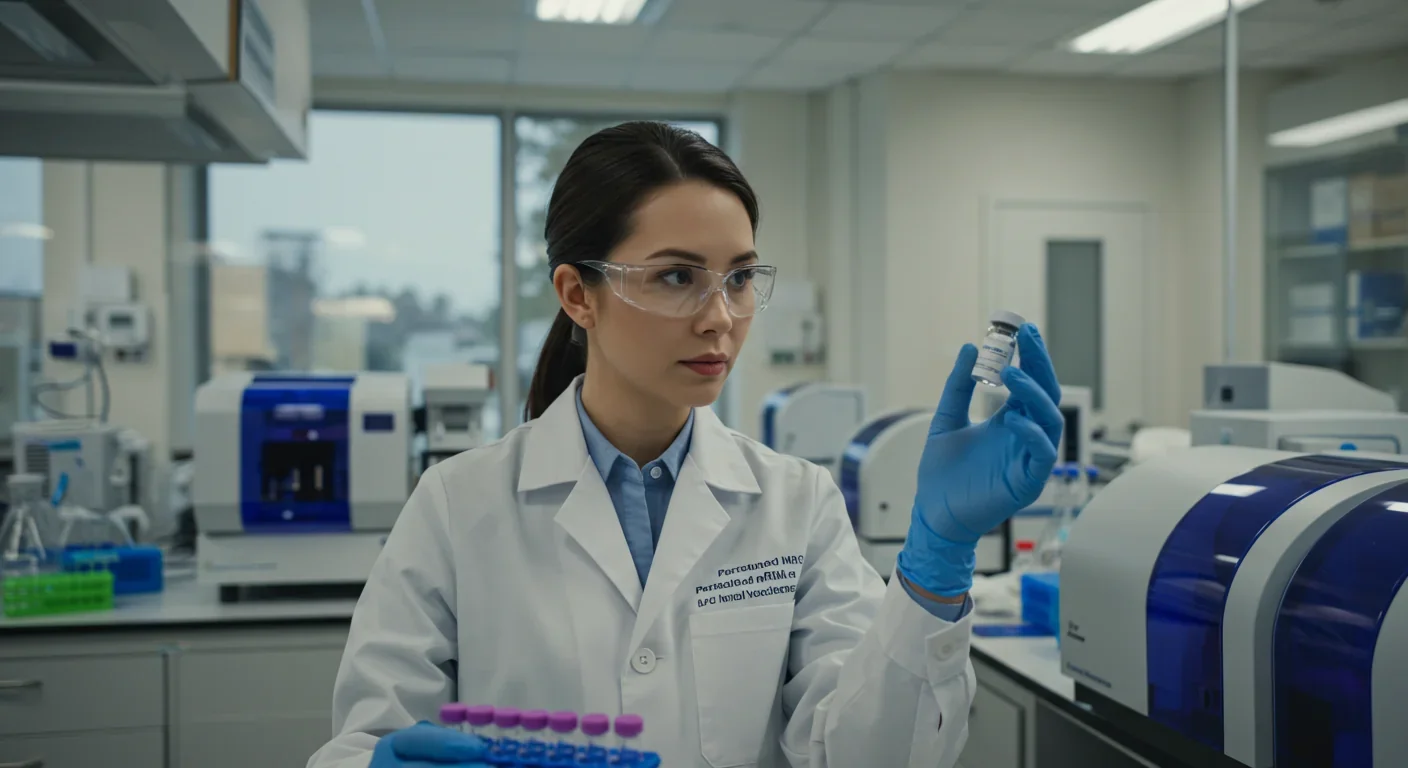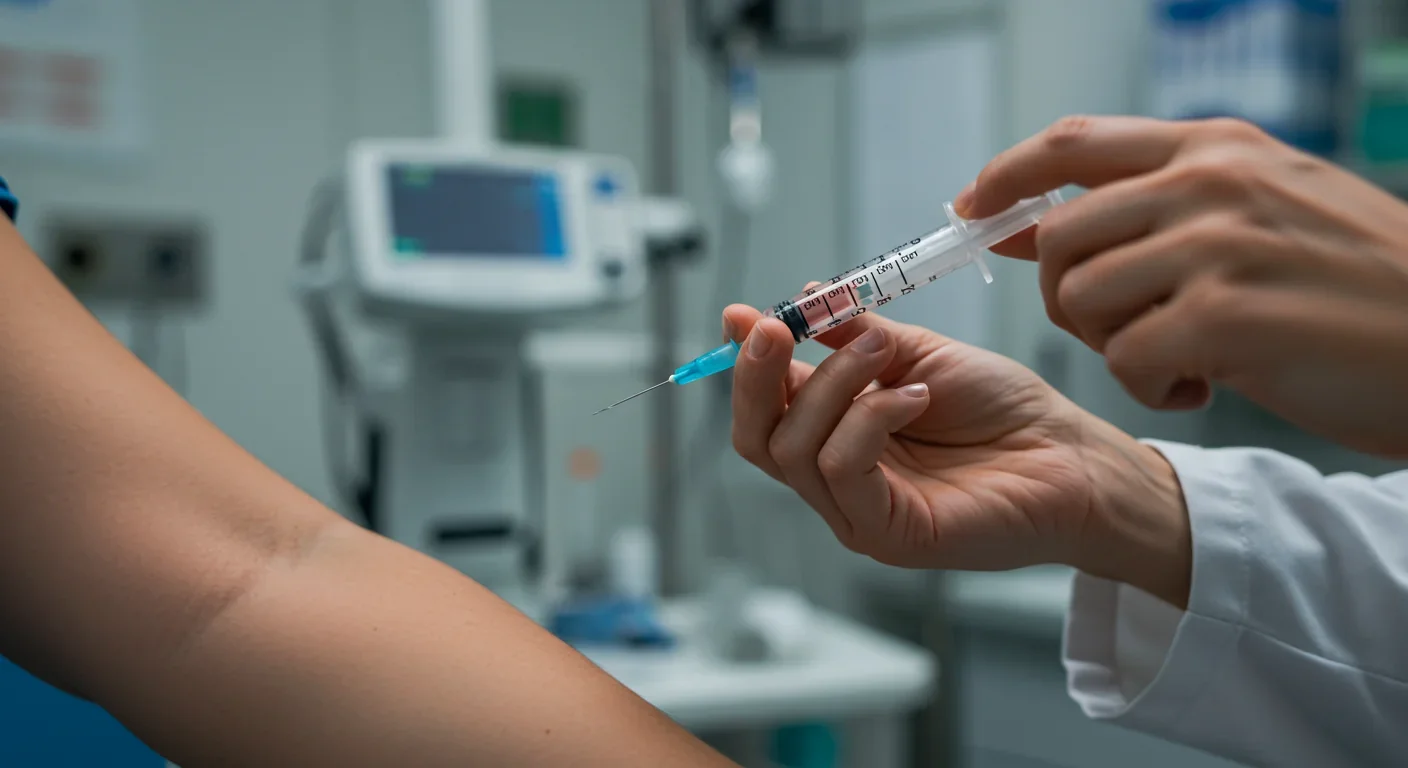Epigenetic Clocks Predict Disease 30 Years Early

TL;DR: Cancer vaccines train your immune system to target tumor cells instead of using chemotherapy. Personalized mRNA vaccines reduced melanoma recurrence by 44% in recent trials, and the technology is advancing rapidly across multiple cancer types.

Within the next decade, your doctor might prescribe you a personalized vaccine—not to prevent cancer, but to cure it. Unlike the vaccines you received as a child, these aren't teaching your body to fend off viruses. They're training your immune system to hunt down and destroy tumor cells hiding in plain sight, cells that have been masquerading as normal tissue for years. The paradigm is shifting from poisoning cancer with chemotherapy to empowering your own biology to eliminate it.
In 2024, researchers reported something remarkable: a personalized mRNA vaccine combined with pembrolizumab reduced melanoma recurrence by 44% compared to pembrolizumab alone. Patients receiving the combination therapy had a recurrence-free survival rate of 79% at 18 months, versus just 62% for those on checkpoint inhibitors alone. That's not a marginal improvement—that's the difference between relapse and remission for hundreds of patients.
But here's what makes this truly revolutionary: each vaccine was custom-built for the individual patient. Scientists sequenced each person's tumor, identified the unique mutations that made their cancer distinct, and manufactured a vaccine targeting those exact molecular fingerprints. The vaccine didn't need to work for everyone. It only needed to work for you.
This isn't science fiction. It's happening right now in clinical trials across melanoma, prostate cancer, lung cancer, and beyond. The first therapeutic cancer vaccine, sipuleucel-T (Provenge), was FDA-approved back in 2010 for metastatic prostate cancer. In the pivotal trial, sipuleucel-T extended median survival by 4.1 months—from 21.7 to 25.8 months. While that might sound modest, for patients facing terminal diagnoses, every month matters.
Think of cancer cells as master disguisers. They're your own cells gone rogue, so your immune system struggles to tell friend from foe. Therapeutic cancer vaccines solve this problem by acting as wanted posters for your T cells—immune soldiers that can kill infected or malignant cells.
Preventive vaccines like HPV work by training your immune system to recognize a virus before you're exposed. Therapeutic cancer vaccines take a different approach: they teach your immune system to recognize tumor-specific mutations after cancer has developed. These mutations, called neoantigens, are the molecular typos that occur when cells turn cancerous. Because they're unique to the tumor, they become perfect targets.
The process works like this: First, doctors take a biopsy of your tumor and sequence its DNA alongside your normal tissue. Algorithms then predict which mutations are most likely to trigger an immune response. The top 20-30 neoantigens are encoded into mRNA and wrapped in lipid nanoparticles—the same technology that powered COVID-19 vaccines.
When injected, these nanoparticles deliver the mRNA into your dendritic cells, the immune system's intelligence officers. The dendritic cells read the instructions, produce the tumor proteins, and present them to T cells. Now trained to recognize the enemy, your T cells proliferate and seek out any cell displaying those neoantigens. If a cancer cell tries to hide, your immune system finds it anyway.
The KEYNOTE-942 trial in melanoma wasn't a fluke. Across multiple cancer types, therapeutic vaccines are proving they can extend survival and reduce recurrence.
For prostate cancer, sipuleucel-T remains the gold standard. The treatment involves harvesting a patient's white blood cells, exposing them to a prostate cancer antigen fused with an immune stimulant, and reinfusing them. Though the manufacturing process is complex and costly, the therapy demonstrated a survival benefit in a phase III trial of 512 men with metastatic castration-resistant prostate cancer.
In melanoma, personalized neoantigen vaccines are advancing rapidly. The KEYNOTE-603 phase I trial showed 8 partial responses and 3 complete responses among patients treated with the mRNA-4157 vaccine plus pembrolizumab. Importantly, patients with low PD-L1 expression—who typically don't respond well to checkpoint inhibitors alone—saw even greater benefit from the vaccine combination. That suggests the vaccine can activate immunity through pathways checkpoint inhibitors can't reach.
Other trials are testing vaccines for lung cancer, bladder cancer, and pancreatic cancer. The ongoing V940-001 trial (INTerpath-001) has enrolled over 1,000 melanoma patients to evaluate long-term outcomes. Early data suggest these vaccines don't just delay progression—they may fundamentally alter the trajectory of disease.

Meet John, a 68-year-old man diagnosed with stage III melanoma after a routine skin check. After surgery removed the primary tumor, his oncologist recommended adjuvant therapy to prevent recurrence. Instead of standard chemotherapy, John enrolled in a clinical trial for a personalized mRNA vaccine combined with pembrolizumab.
Within three weeks of his biopsy, his custom vaccine was ready. He received nine doses over six months. The side effects? Chills, fatigue, fever, and injection-site pain—manageable and temporary. Three years later, John remains cancer-free.
Stories like John's are becoming more common, but they're not universal. Not every patient responds. Some tumors evolve to evade the immune system even after vaccination. Others lack sufficient neoantigens to target. And because these therapies are still experimental outside a few FDA-approved options, access remains limited to clinical trial participants or patients who can afford out-of-pocket costs exceeding $100,000 for personalized vaccines.
Cost is the elephant in the room. Sipuleucel-T's manufacturing involves leukapheresis and custom cell processing, driving prices into six figures. Even with insurance coverage, reimbursement battles and access barriers mean many patients never receive it. Peak revenues for Provenge hit $300 million annually in the early 2010s but have since dropped below $200 million—a sign of limited adoption.
Personalized mRNA vaccines face similar hurdles. The pipeline from biopsy to vaccine takes 3-4 weeks, requiring whole-exome sequencing, computational epitope prediction, mRNA synthesis, and quality control. For patients with aggressive tumors, that lag can be too long. Scaling production to treat thousands—or millions—of patients will require automation, standardization, and substantial infrastructure investment.
Then there's the scientific challenge: tumor heterogeneity. A single tumor can harbor multiple clones with different mutations. If the vaccine targets only a subset of neoantigens, resistant clones can proliferate and cause relapse. Researchers are exploring broader antigen panels and "off-the-shelf" vaccines targeting shared tumor antigens, though these lack the personalization that makes neoantigen vaccines so potent.
Immune resistance is another obstacle. Tumors create immunosuppressive microenvironments that shield them from T-cell attack. Regulatory T cells, myeloid-derived suppressor cells, and checkpoint molecules like PD-L1 all dampen immune responses. That's why vaccines often work best when combined with checkpoint inhibitors, which release the brakes on T cells.
The future of cancer immunotherapy isn't monotherapy—it's combination therapy. Checkpoint inhibitors like pembrolizumab and nivolumab have transformed oncology by blocking PD-1 and CTLA-4, molecules that tumors exploit to evade immune attack. But only 20-40% of patients respond to checkpoint inhibitors alone.
Enter therapeutic vaccines. By flooding the tumor microenvironment with activated, tumor-specific T cells, vaccines can convert "cold" tumors—those lacking immune infiltration—into "hot" tumors primed for checkpoint blockade. Ongoing trials are testing vaccines plus checkpoint inhibitors, plus radiotherapy, plus chemotherapy. The goal is synergy: each therapy compensating for the others' weaknesses.
One promising strategy pairs vaccines with dendritic cell therapies. Dendritic cells are the immune system's master antigen-presenting cells. By loading them ex vivo with tumor antigens and reinfusing them, doctors can amplify the vaccine's effect. Early trials show that DC vaccines combined with checkpoint inhibitors enhance T-cell activation and improve response rates.
Another approach uses hydrogel-based vaccines, which slowly release antigens and adjuvants at the injection site, creating a sustained immune response. These biomaterial platforms could reduce the number of doses needed and improve vaccine stability, making them easier to distribute globally.

If you or a loved one is facing a cancer diagnosis, here's what you need to know:
1. Ask about clinical trials. Most cancer vaccines aren't FDA-approved yet, so trials are the primary access route. Search ClinicalTrials.gov for studies in your cancer type. Many trials cover the cost of the vaccine.
2. Timing matters. Vaccines work best when tumor burden is low—after surgery or in early-stage disease. Don't wait until you've exhausted all other options.
3. Biomarkers can guide decisions. Tumors with high mutational burden (like melanoma and lung cancer) tend to have more neoantigens, making them better vaccine candidates. Ask your oncologist about tumor sequencing.
4. Side effects are generally mild. Unlike chemotherapy, vaccines don't kill rapidly dividing cells indiscriminately. Most side effects—fever, fatigue, injection-site reactions—resolve within days. Serious adverse events, like autoimmune reactions, occur in fewer than 10% of patients.
5. Insurance coverage varies. For FDA-approved vaccines like sipuleucel-T, Medicare and most private insurers provide coverage, though prior authorization may be required. Investigational vaccines in trials are typically free.
Cancer vaccines represent a fundamental shift in how we think about treatment. Instead of asking "What drug kills this cancer?" we're asking "How can we teach your immune system to kill your cancer?"
The technology is advancing rapidly. Next-generation mRNA vaccines are incorporating self-amplifying RNA, which replicates inside cells to produce more antigen with lower doses. Artificial intelligence is improving neoantigen prediction, identifying epitopes most likely to provoke strong immune responses. And researchers are developing "off-the-shelf" vaccines targeting shared tumor antigens, which could be mass-produced and deployed quickly.
Within five years, we'll likely see FDA approval for personalized mRNA vaccines in melanoma. Within ten, vaccines could become standard of care for multiple cancer types, prescribed alongside or even instead of chemotherapy for certain patients.
The economic model will need to evolve. Right now, personalized vaccines are boutique therapies available to the few. To reach the many, manufacturers must streamline production, regulators must create adaptive approval pathways, and payers must recognize the long-term value of durable responses versus repeated rounds of chemotherapy.
But the science is sound, the clinical data are promising, and the momentum is undeniable. For the first time in oncology, we're not just fighting cancer—we're teaching the body to fight it for us. And that's a future worth believing in.

Recent breakthroughs in fusion technology—including 351,000-gauss magnetic fields, AI-driven plasma diagnostics, and net energy gain at the National Ignition Facility—are transforming fusion propulsion from science fiction to engineering frontier. Scientists now have a realistic pathway to accelerate spacecraft to 10% of light speed, enabling a 43-year journey to Alpha Centauri. While challenges remain in miniaturization, neutron management, and sustained operation, the physics barriers have ...

Epigenetic clocks measure DNA methylation patterns to calculate biological age, which predicts disease risk up to 30 years before symptoms appear. Landmark studies show that accelerated epigenetic aging forecasts cardiovascular disease, diabetes, and neurodegeneration with remarkable accuracy. Lifestyle interventions—Mediterranean diet, structured exercise, quality sleep, stress management—can measurably reverse biological aging, reducing epigenetic age by 1-2 years within months. Commercial ...

Data centers consumed 415 terawatt-hours of electricity in 2024 and will nearly double that by 2030, driven by AI's insatiable energy appetite. Despite tech giants' renewable pledges, actual emissions are up to 662% higher than reported due to accounting loopholes. A digital pollution tax—similar to Europe's carbon border tariff—could finally force the industry to invest in efficiency technologies like liquid cooling, waste heat recovery, and time-matched renewable power, transforming volunta...

Humans are hardwired to see invisible agents—gods, ghosts, conspiracies—thanks to the Hyperactive Agency Detection Device (HADD), an evolutionary survival mechanism that favored false alarms over fatal misses. This cognitive bias, rooted in brain regions like the temporoparietal junction and medial prefrontal cortex, generates religious beliefs, animistic worldviews, and conspiracy theories across all cultures. Understanding HADD doesn't eliminate belief, but it helps us recognize when our pa...

The bombardier beetle has perfected a chemical defense system that human engineers are still trying to replicate: a two-chamber micro-combustion engine that mixes hydroquinone and hydrogen peroxide to create explosive 100°C sprays at up to 500 pulses per second, aimed with 270-degree precision. This tiny insect's biochemical marvel is inspiring revolutionary technologies in aerospace propulsion, pharmaceutical delivery, and fire suppression. By 2030, beetle-inspired systems could position sat...

The U.S. faces a catastrophic care worker shortage driven by poverty-level wages, overwhelming burnout, and systemic undervaluation. With 99% of nursing homes hiring and 9.7 million openings projected by 2034, the crisis threatens patient safety, family stability, and economic productivity. Evidence-based solutions—wage reforms, streamlined training, technology integration, and policy enforcement—exist and work, but require sustained political will and cultural recognition that caregiving is ...

Every major AI model was trained on copyrighted text scraped without permission, triggering billion-dollar lawsuits and forcing a reckoning between innovation and creator rights. The future depends on finding balance between transformative AI development and fair compensation for the people whose work fuels it.